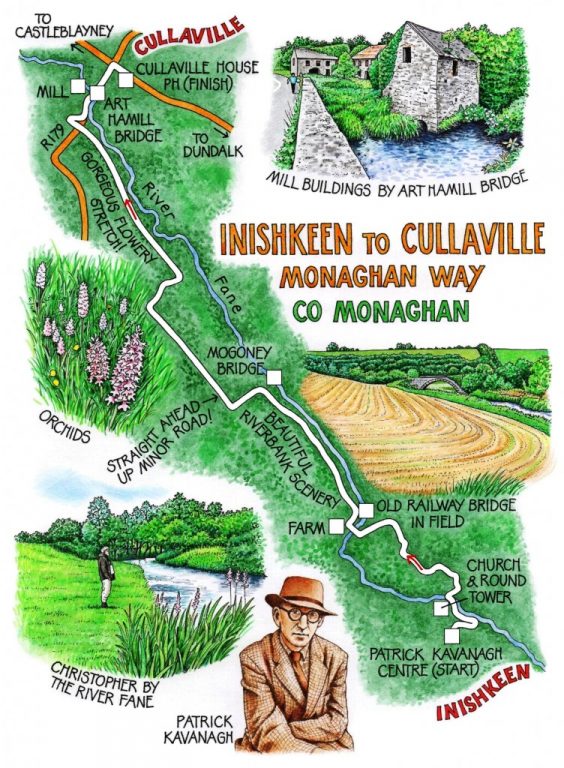Irish Independent Walk of the Week Christopher Somerville
6 August 2011
107: Inishkeen to Cullaville, Monaghan Way, Co. Monaghan

‘ … “Who owns them hungry hills
That the water-hen and snipe must have forsaken?
A poet? Then by heavens he must be poor.”
I hear and is my heart not badly shaken?’
One of the most striking verses in all Patrick Kavanagh’s poetry drew me to Kavanagh’s birthplace of Inishkeen in the steep Monaghan countryside. Here the poet sowed and ploughed, suffered the mental anguish of the rural misfit, and nurtured his extraordinary gift. The poem ‘Shancoduff’ encapsulates perfectly the spiky genius of this small-time farmer who ripened into Ireland’s greatest rural poet of the mid-20th century. Black hills looking north towards Armagh, sleety winds, grumbling drovers and perishing calves – they are all there, present and correct, along with a bitter optimism and a subtle pinch of humour.
‘He’s the genius of this place,’ said Rosaleen Kearney, administrator of the Patrick Kavanagh Centre in Inishkeen, as she showed us around the beautifully laid-out displays. ‘He caught what’s here, and also what’s underneath.’ Casual visitors, dedicated Kavanagh fans, would-be poets and parties of schoolchildren all fetch up at the old church that houses the centre. Outside lies the poet’s modest stone-slabbed grave with its simple wooden cross.
Lucky or well-informed visitors find their way from here to the start of the Monaghan Way, a 40-mile walking route to Monaghan town. ‘It follows the trackbed of the old Dundalk to Enniskillen railway,’ said Thomas McSkane, one of the path’s original begetters, outlining the route for us. ‘You’ll find it a really beautiful way to walk through the heart of Patrick Kavanagh Country.’
A stony lane led us away from Inishkeen to drop down a bank onto the old railway. The gently rising track ran between shaggy hedges, a straight man-made line through a twisty, lumpy countryside full of steep little drumlin hills and hollows, a landscape moulded in gravel heaps as the glaciers of the last Ice Age ground rocks to rubble and spewed them forth during their final retreat. A land watered by the peacefully winding Fane River, squared into grazing meadows by hedges and divided between dozens of small, hard-worked farms of the kind that ground and moulded Patrick Kavanagh.
Rich smells of newly mown hay, cow dung and agricultural diesel followed us along the old railway, out across the fields and down country lanes where ancient, square-rigged tractors went chuntering along at snail’s pace. A gracefully arched stone bridge marked the course of the railway, and once back on the track we entered a sublime piece of river country, walking through hayfields under huge old willows where the River Fane chuckled and rushed under rippling mats of white-flowered waterweed. The railway trackbed, intersected here and there by broken bridges, was a riot of marsh orchids and yellow rattle, dog roses and marguerites. It was a wrench when at least we left the Monaghan Way at Art Hamill Bridge and sauntered dreamily up the lane into Cullaville.
Patrick Kavanagh died of cancer in 1967 in Dublin, far from these Monaghan farmlands that cursed and blessed him. The epitaph on his grave could not have been better chosen: ‘… And pray for him who walked apart on the hills, loving life’s miracles.’
WAY TO GO
Map: OS of Ireland 1:50,000 Discovery Sheets 28 and 36A; downloadable map/instructions at discoverireland.ie/walking; leaflet guide map (see below) is not entirely accurate!
TRAVEL: N58 (Castleblayney-Dundalk); 3 miles/4.5 km beyond Cullaville, right (‘Inishkeen, Patrick Kavanagh Centre’). In ⅓ mile/0.6 km, left (‘Inishkeen’). In 1½ miles (2.5 km) right at T-junction; in 1 mile/1.6 km, at crossroads, right into Inishkeen. Park opposite Patrick Kavanagh Centre.
WALK DIRECTIONS: From Patrick Kavanagh Centre, right along road. In 150 m, cross road and go left along River Fane path (‘Monaghan Way’/MW) to river bridge. Cross bridge; on along road under railway bridge; round bend. Left (MW); up field slope by hedge, over stile, right up boreen (MW). In 200 m, left over stile (MW); ahead over crest, down slope to old railway (MW); right along railway track. In a few hundred metres, right (MW) beside game pen; up field to lane, left to road. Left (MW). In 200 m, right (MW) over river, up farm drive. In 20m, right (MW) through wicket gate. Aim for stile in far hedge, then for bridge ahead. Left here through fields by river (MW, stiles) for 1⅓ miles/2 km to Mogoney Bridge. Left along road (MW). In 400 m, right at crossroads (MW). In ½ mile (0.8 km) at left bend, keep ahead up minor road (MW). In ⅓ mile (0.5 km), right up boreen (MW). At end, over stile (MW), up field slope to stile onto old railway (MW). Left and follow railway for 1½ miles (2.3 km) to bridge over R179. On for 100 m; right down slip road; left along R179 to Cullaville.
LENGTH: 7 miles/12 km; allow 3-4 hours.
GRADE: Moderate
CONDITIONS: Often boggy and uneven underfoot.
DON’T MISS:
• Patrick Kavanagh Centre
• Scenery along River Fane
• Wildflowers of the old railway.
REFRESHMENTS: Delicatessen/café opposite Cullaville House PH, Cullaville, or picnic by River Fane.
ACCOMMODATION: Gleneven House, Inishkeen (042-937-8294; gleneven.com)
PATRICK KAVANAGH CENTRE, Inishkeen, Co. Monaghan (042-937-8560; patrickkavanaghcountry.com) – writers’ weekends, performance tours, schools programme etc.
Patrick Kavanagh: Collected Poems (Penguin)
MONAGHAN WAY: leaflet guide from Monaghan TIC (Mullacroghery, Clones Road; 047-81122; discoverireland.ie/northwest)
.
WALKING in IRELAND: Walking tour operators, local walks including Discover Ireland’s National Loop Walks, walking festivals throughout Ireland: discoverireland.ie/walking.
BOOK: Christopher’s book Walking in Ireland (Ebury Press) contains 50 of his favourite Irish Independent walks.
csomerville@independent.ie